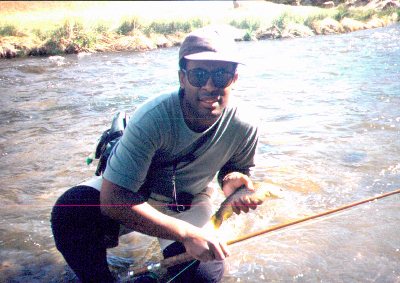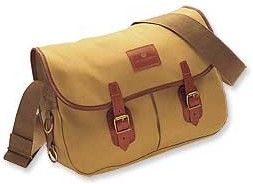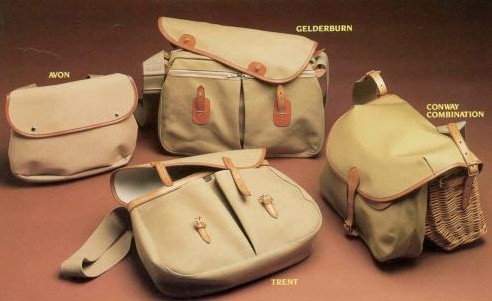|
|
|
|
|
The Anti- Vest I’ve probably run the gamut of fly fishing vest alternatives. From nothing but a fly box and spool of tippet in my pocket to camera bag, fly fishing vest, fanny pack, fly fishing back pack (never again), back to camera bag and currently British style fishing bag. They all have their pros and cons I suppose, all fulfill a need I think I have at the time, their usefulness, to come into question at some time or another. What makes a good anti-vest depends on the angler’s preferences but also more importantly on need. Those who choose the anti-vest almost certainly undergo a transformation. As a young upstart fly fisher I, like most, had very little equipment. I quickly outgrew the stuff everything in my pockets phase and graduated to a small Eddie Bauer camera bag that I received for X-mas. Realizing the efficacy of such a bag for fishing, I quickly transformed it into a fishing bag and purchased another identical bag for camera use. The camera was quite adequate but I slowly felt the need to conform. I watched other anglers fish in their vests and wondered what I was missing. There is of course nothing wrong with a vest but as a small person I felt the vest was cumbersome. It was heavy, hindered my movement and hampered the agility fly fishers sometimes need to avoid sudden stream-side mishaps. I also found myself buying things so that I could fill my vest. Items that while useful, were in the “just in case” or “nice to have” category and over the year or so that I wore my vest saw very little use. Again, I decided a change was in order; unfortunately, I found I was bloated- gear wise. Thus began the transformation. I didn’t want to give up the convenience of having just about anything I wanted, when I wanted it. I wanted to “eat my cake and have it too.” (The correct quotation of this phrase by the way.) I had to discover ways of cramming all that gear into a much smaller space. This of course led to buying new, more efficient gear. I went from carrying 4 or 5 fly boxes down to 2 by purchasing a wheatly swing leaf box and a knock off wheatly combination compartment and foam box. I developed a tippet carrier that allowed me to hang 4 spools of tippet one on top of the other out side the bag, instead of side by side in the vest. (I later purchased one of the T variety tippet holders when they became available.) I purchased smaller scissors. Dropped the multi size split shot carrier, and 1 packet each of size B and BB split shot in favor of carry both size B and BB shot in a film case. The various packs of different types of indicators were reduced to several corkie type indicators that fit quite nicely in the same film case as the split shot. That life time supply of 3 different color indicator yarns was reduced to 5 inches each of orange and green. I became more honest about my fishing needs. Gone where the 8 and 7x tippet spools I purchased on sale and carried “just in case”. Gone where all the specialized dry flies for those ultra selective fish that I never seemed to encounter. Gone was any dry fly that I could not see when I fished. Gone were all the flies that I tied from watching various fly tying videos but never used. Insect repellant and sun screen? They’d stay in the travel bag in my car. Borger Color System booklet for that exact “match the hatch” fly tying color….take a hike. What was left was all I truly needed to catch fish. The camera bag carried two wheatly fly boxes, one for nymphs and wets and one for dries. Four spools of tippet, several packets of leaders, the film canister of shot and indicators, some original Orvis super float (the super toxic stuff they don’t sell anymore) and a waterproof camera.
The camera bag served me well for many years and I would still be using it if I hadn’t decided in my later years that it might be prudent to carry some useful items such as food, water and a snakebite kit. Throw in the fact that my make shift tippet contraption had me trailing tippet like a spider and a larger bag was in order. Enter the traditional British Fishing bag. What better way of carry fishing gear than a bag which was designed for that purpose and has survived the test of time. For the past two years I’ve carried a John Chapman Troutbeck 14 bag for all my fishing except day hikes and backpack trips. The only reason I don’t use the bag for day hikes is that I can’t comfortably fit the additional first aid kit and water purification pump that I like to carry; I’d need a Troutbeck 16 for that. What I’m calling a “traditional” British Fishing Bag is simply a canvas bag that is used for fish and game. You find these on old photographs of Sawyer and Skues- bag on the shoulder and bamboo rod in hand. There are several manufactures of these bags (see list below) the most well known brands being Hardy and Brady. Most bags are of similar design and construction- layered canvas bonded over a rubber core. These bags are water proof and rot proof and most can accept rubber liners which can be used to separate gear or carry fish. My current bag, the Chapman Troutbeck 14 is 14x10x3.5 inches with a large interior space and two bellows pockets on the outside. A small interior pocket is found in the main compartment. This pocket is unique to Chapman bags, is large enough to slip your hand in and is perfect to carry keys, wallet, leader envelopes or a few spools of tippet. I use it for the latter two. In addition, it has a nice, wide should strap with a brass ring to carry nets, attach a wading staff or homemade seine. Unlike most bags, Chapman bags place the ring high the shoulder strap. This ensures that items do not drag on the ground and is a particularly nice feature.
Types of Fishing Bags
The most basic bag is the single pocket bag. These bags are generally about 12x10x3, give or take an inch here or there, and provide the fly fisher with a single pocket with perhaps a partition in which to place their gear. These bags, such as the Hardy Brook Bag, Chapman Highland Burn and Roebeck and Brady Avon are for the true minimalist- those folks who look for the smallest of the small. An upgrade to these single pocket bags
in function are what I would call the “mini-field bag”. These bags employ
the inclusion of out side bellows pockets. This allows some additional
storage space but more importantly it allows greater separation and
organization of gear. These are the bags for the “A” personality minimalist.
Arguably the most popular and most practical bag is the “standard fishing bag”. These bag range in sizes from 14x10x3.5 to 18x15x5 and are characterized by a single large interior pocket and two large bellows bags. The majority of the available bags are of this type. Chapman’s Troutbeck series, Hardy’s Test and Aln, and Brady’s Trent, Stour, Arrow and Gelderbrun fall into this category. Brady’s Severn and Hardy’s Carry All Bag are variations on this theme and include an additional rear pocket. Other bags are more unique in styling. The “Net Bags” have a more square shape than the standard bags and include exterior netting. There is little diversity here, Hardy’s Troutfisher measures 15x14 and Brady’s Wye comes in at 14x14. The Chapman bags are the standout in this category with 3 sizes from 14 to 18 inches in the standard rectangular shape. There are bags for everybody and for the truly fastidious angler, Hardy offers the 17x11 Compact bag with “plenty of storage space” and a pair of internal and external bellows pockets. Chapman offers a similar bag called the Coquet. For something completely different, fly fishers would do well to check out Brady’s Conway Combination. It is a one of a kind behemoth- half wicker creel, half canvas bag and is much larger than its stated measurements.
Fittings Not all bags are created equal. The fittings on the bags play an important role in the practicality of the bag as a fishing tool. There are three types of fittings- straps and buckles, snaps or in British parlance “poppers” and clogballs. Clogballs are basically brass rivets over which a leather strap is fitted; they are far and away the best choice for a fishing bag. Clogballs securely hold the bag flaps in place, yet disengage with one quick flip. Straps on the other hand are simply a pain to fiddle with. With clog balls, you can access gear by feel. You can do the same with straps and buckles but it is simply harder, takes more practice and requires more concentration. In addition, buckles can be hard to handle with gloves or in cold weather. Snaps are as easy to open as poppers but at times can be less secure. Snaps require some sort of structure to provide enough resistance to lock properly. This resistance takes the shape of whatever you have in your bag. You push until the back of the snap pushes back and, voila, if you’re lucky it locks. Snaps can also be too secure, refusing to open when need. An additional advantage of clog balls is that they can come with a clog ball on one end and a strap and buckle on the other. This allows you to adjust the bag for larger loads while still allowing easy access. Hardy bags come with clog balls or buckles depending on the design. Brady uses straps on most of its bags; however, there are exceptions. Chapman uses both clog balls and snaps on its Cumberland line of bags and straps and buckles on its Highland range of bags.
You and Your Bag So which bag is right for you? To figure that out, lay all of the gear you intend to carry out in front of you. The one thing that carrying a bag does is make you honest about what it is you really need. It’s a liberating experience. Once you’ve figured out what comes and goes, arrange the gear as if you were stuffing it in a bag laid out in front of you. Now take the measurements of your imaginary bag. This will give you a basis for the size of the bag you need. Now, simply apply that basis to the features you might want and your decision is made. If a particular bag is the right size but does not contain the features you fancy, note the size of the bag and try to rearrange your gear to fit an imaginary bag with your desired features. Chapman bags excel at providing the angler exactly what is needed. Most Chapman bags come in a variety of sizes and the company is willing to custom make a bag to order. At present I am waiting on a new Chapman bag to replace the Hardy Carryall which I use a briefcase bag. Chapman is making me a Troutbeck type bag similar in size to the Carryall. The differences between the Carryall and this bag are that the Carryall has an external back pocket the length of the bag and the Troutbeck has the small interior pocket I mentioned earlier. The bellows pockets on the Troutbeck have snaps, where as the Carryall has clog balls. I asked Chapman to provide me with an interior pocket the length of the bag and a large 6x5 pocket which I can use to hold CDs with. I also asked for darker trim than their standard bags and clog balls on the interior pockets. What I end up with will essentially be a custom Carryall type bag, which will cost $50 less than a true Carryall. (Update 2020: The bag I settled on is essentially a modified Chapman Fell to which I had them remove the outer rear pocket and install two internal bellows pockets and two slip pockets.)
Where to Buy I’ve concentrated mainly on Hardy, Brady and Chapman because they’re really the only fishing specific bags. There are some others bags of similar construction that are basically one offs (such as the Barbour bags) or that were not made specifically with fishing in mind (such Billingham). The others brands simply don’t have the variety or specificity of Hardy, Chapman or Brady. In addition, very many of these bags share the same producers. I’ll leave it to you to figure out which. Below is a listing of manufactures web sites and/or dealers.
Bag Companies Fishing Specific Bags: John Chapman- https://www.chapmanbags.com/us/ House of Hardy-
http://www.hardyfishing.com/hardy-luggage/
Retailers
Updated Jan. 2020. I've removed the retailer links as most of them were out of date. Google is a good resource for comparison shopping. Keep in mind that Brandy will custom build a bag for you.
|





